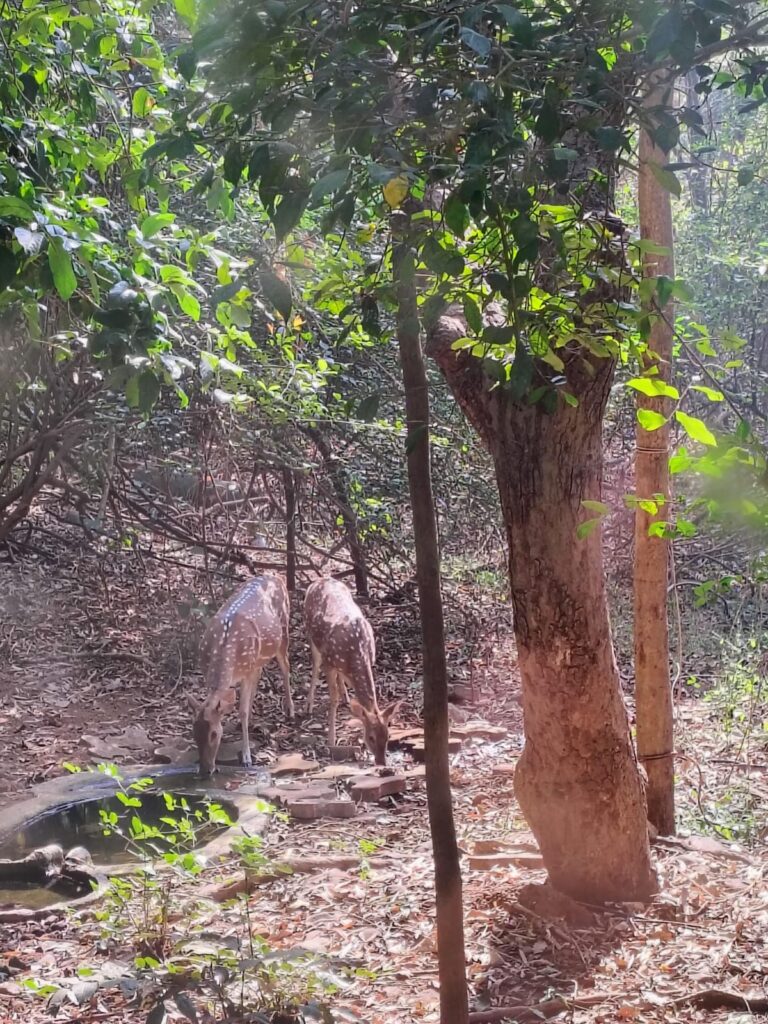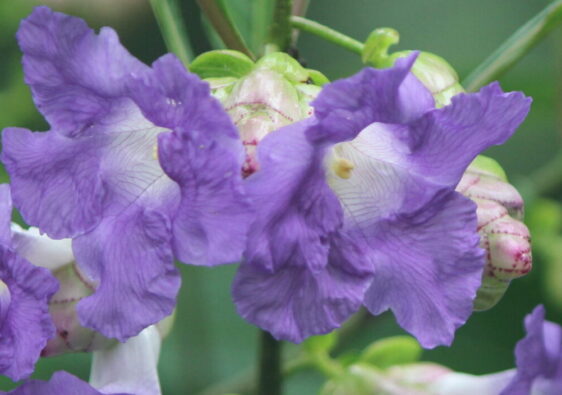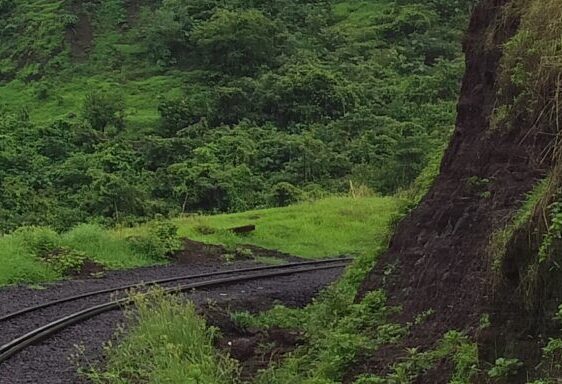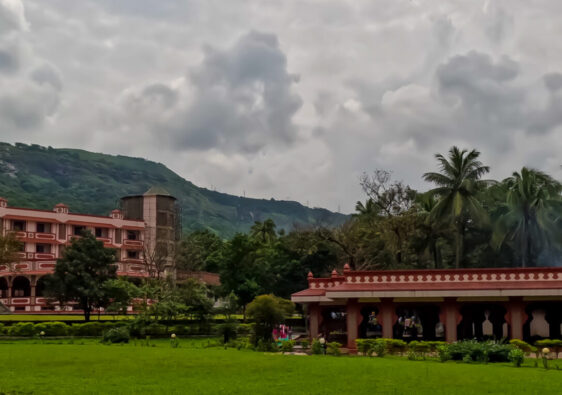
It is 31st December, 2024. There is excitement in the air as people gather to celebrate the coming of the New Year in their own inimitable ways. At home, I wait for the clock to strike 12 with the dramatic twelve chimes announcing the arrival of the year 2025. I quickly wish my loved ones and go to sleep. Yes, you read it right, sleep! No room for parties. Usually, you won’t see me or even Steffe for that matter socialising much. When we are not travelling, you will find us spending moments in the natural world. Going bird watching, nature trails or simply idling in the forest is what truly defines our fraternity.
We exuberantly waited for the crack of dawn to begin our New Year with a forest trail. And that too with the team of the Bombay Natural History Society (BNHS). What better could we ask for? On the first day of the new year going on a lovely trail beginning from the Conservation Education Centre (CEC BNHS) and ending all the way up to Vihar Lake in the core forest of Sanjay Gandhi National Park (SGNP).
Mumbai is experiencing its strong and pleasant winter months with temperatures dropping to 14°C. There was a chill in the air as we rode through the empty streets towards Film City in Goregaon. Everything seemed a little fresher and in a clean state. A fresh breeze is indeed one of the magic tricks of nature. Inside the Film City gates, CEC BNHS is located adjacent to national park, encompassing 33 acres of natural forest. The forest has extensive nature trails, offering ample opportunities for observing the wilderness traversing diverse habitats.
It was still pitch dark as we entered the gate of BNHS. Around 100 participants from various walks of life had assembled at the center. It felt good to see people participating in large numbers and some even introducing their children to the wonders of nature. Led by the experienced senior educational officer Shardul Bajikar and his passionate team of naturalists, the participants were divided into a group of five. Ten years ago, I had done my first-ever nature event, ‘Walking With The Trees,’ in SGNP under the expertise of Shardul. It was an inspiring and encouraging walk for an amateur like me. I always looked forward to the events led by him. And last week when I received an email from BNHS about this trail with Shardul in the loop, I thought to myself, this is surely not to be missed.
Thus, the dates were immediately blocked, and on the 1st day of the New Year, we embarked on a morning trail to Vihar Lake.


To the best of my knowledge, there are 3 trails in the BNHS reserve forest, named as the Salim Ali Point trail (ST), Leopard trail (LT), and Karvi trail (KT). Over the years, we have completed all the trails through various events conducted by the BNHS team. And every time there are different learnings and experiences. I still remember our first Karvi trail in 2016 when the flowers were in full bloom. The vibrant purple blanket of Karvi flowers had left me in awe as I experienced the rich flora and fauna of the BNHS Nature Reserve. Another experience that remains etched in memory is the Leopard Trail done in monsoon. The BNHS had announced its first trail after the Covid lockdown was partially lifted. To our surprise, I and Steffe were the only two participants for this event. And it was very kind of the BNHS team not to cancel it. Dilip Kaka, the man with over 25 years of practical experience in the forest, led us through the trail explaining the various plants, wildflowers, and stories of his encounters with leopards.
On this occasion, BNHS, in collaboration with SGNP, provided an opportunity to go on a trail to Vihar Lake, which is a restricted zone and not accessible to the general public. Each group walked through different trails in the BNHS forest, which then opened up on a road leading towards the lake that comes under the territory of SGNP.

Our group walked on the Leopard Trail, led by Hitendra, who keenly checked the culverts for any sighting, primarily leopard, which has been seen in this spot several times. When in the wild, there is always an excitement that we want to see an animal, a leopard or a tiger. Tigers do not exist in the national park except in the enclosed safari. The last unconfirmed tiger sighting was reported in 2002, in the Nagla Block section of SGNP, north of Vasai creek. But yes, there are around 50 leopards in SGNP roaming freely in the forest. And of course, it is the star attraction for many visiting the trails, but one needs to be extremely lucky to see this elusive beauty. There is a hundred percent chance that the leopard might be seeing you, but your chances of seeing him are very low. Hitendra, even after his 15 years of time in the forest, says he has spotted the leopard only twice.
Leopard or no leopard, this trail had a unique charm. We walked on the dry riverbed amidst the fallen old leaves. The sun slowly shone between the canopy of a barren tree. But the big cat made its presence felt in the forest through its claw marks on the gum karaya tree, which stood alone on the edge of the riverbed. This they do to mark their territories and maintain their claws. The gum karaya tree (also known as the ghost tree) had shed most of its leaves, and panicles of flowers appeared at the end of its leafless branches. I like to see this deciduous tree, which looks striking even from a distance. As we were trying to identify birds through their calls, an Indian Grey Hornbill flew majestically above us. Little ahead we even saw the scat of a leopard on a grass tuft along the trail. The scat gives a valuable source of information about their diets. In the forest of SGNP, the leopard’s diet mostly consists of domestic prey like stray dogs and cats easily found in the tribal settlements.
The Brown-headed Barbet continued its singing while we were being informed about various species of trees and their uses. The trail gently climbed, and after traversing a difficult patch, it met the main road, which connected to the lake. A herd of Spotted Deer crossed the road and disappeared into the forest, much to the excitement of the children. A Paradise Flycatcher kept our photographer friends busy while Steffe observed it through binoculars. I had to be content in seeing it fly from one branch to another. Its long ribbon-like tail caught everyone’s attention.


We were at the right place, at the right time. As luck would have it, we spotted a Sambar Deer saunter down the rugged wooded hills. It kept a watch on us for some seconds and disappeared as quickly as it appeared. We stood motionless and gazed at one of India’s largest deer species, known for their large antlers and solitary nature. Our photographer friends were able to capture it in their lens. Those who missed it saw the photograph and were delighted.
Walking beneath the trees spreading their canopies above the road was refreshing. The sunlight fell on the teak tree, turning the leaves into a golden hue. The teak tree has always enchanted me in SGNP with its majestic presence, especially in their fall season. Butterflies, although not in large numbers, kept chasing each other from one leaf to another. Rosy Eranthemum, a shrub with blue or rose-colored flowers with five petals, had bloomed, and a Chocolate Pansy butterfly hovered above it.


A large snake had shed its skin near a culvert where a little stream flowed. Initially it was speculated to be a cobra, but there were no markings on its hood. Possibly it could have been a rat snake. Nearby, there was an abandoned and collapsed termite mound. It is said that when the termites abandon their gigantic mounds, they are often occupied by snakes. Snakes get refuge from the heat and potential predators. But it may also be used by other creatures like lizards, scorpions, and some birds. Hitendra explained to us the ecological significance of termite mounds and how they support soil fertility. Termites also act as indicators of the health of an ecosystem, and their mounds contain a host of information about the ecology of the region. They eat dead and decaying organic matter like logs of wood in a forest, which would otherwise take years to decay.
The trail ended on the road at culvert 18. From here, we bypassed towards the Vihar Lake through the woods. Confined between Tulsi and Powai lakes, Vihar Lake is one of the oldest, partially meeting the water needs of the metropolitan city. The seclusion and protection of the lake due to the curtailment of access to the general public and security received under SGNP has ensured well-wooded natural regeneration. The lake gets its water from rainwater collected in the catchment area of the Powai-Kanheri hill ranges. On a clear day the lake offers a clear view of surroundings and boundless scenic beauty. The water body is home to many aquatic birds like ibises, terns, egrets, cormorants, lapwings, swallows, etc. The presence of several migratory and native birds, in the midst of the beautiful view of the hills, enthralled us.
Among the three species of crocodiles found in India, Vihar Lake is home to a sustainable number of freshwater crocodiles, also known as marsh or mugger crocodiles, which are often found basking in the sun. One of the participants was able to capture a crocodile swimming in the middle of the lake. What a luck!

We were allowed to spend some time at the bank of the lake. After taking some photographs, we both took shelter beneath the cool shade of the trees. Sitting on the hanging branch of a tree, I looked at the vast expanse of the lake and a small island on it. It felt very peaceful to be here. A wedge of ibises flew above the lake in a triangular formation. Their silhouette against the backdrop of a skyscraper reminded me that I live in a city that also houses a forest. A forest with its many vibrant colors, unique trees and rocks, several rare birds, and various insects and animals. I just cannot imagine Mumbai without its national park. It is the green lung for the city, offering a serene escape from the urban hustle and bustle.
A skull of some animal, probably a deer, lay on the forest floor. It had been prey to some stronger animal than him. Was it a crocodile or a leopard? Who knows? In the end, this is the WILD…LIFE. Only the fittest survive.
We are grateful to the BNHS team for organizing this event. Their effort and dedication towards nature are commendable. We will fondly remember this trail for a long time.



List of Birds Seen/Heard on the Trail
(Bird list compiled as observed and seen by Kedar Gore, Joseph Augustine, Radhika, Anushri Joshi & Kiyan)
| 1. Greater Coucal | 8. Black Kite | 15. Common Myna | 22. Swallows |
| 2. Brown-headed Barbet | 9. Indian Grey Hornbill | 16. Rose-ringed Parakeet | 23. Snipes |
| 3. Ashy Drongo | 10. Common Tailorbird | 17. Tickel’s Blue Flycatcher | 24. Palm Swift |
| 4. Purple Sunbird | 11. Indian Golden Oriole | 18. White-naped Woodpecker | 25. Vigor’s Sunbird |
| 5. Yellow-throated Sparrow | 12. Flock of Glossy Ibis | 19. Indian Paradise Flycatcher | 26. Jungle Owlet |
| 6. Jungle Crow | 13. Gull-billed Tern | 20. Red-wattled Lapwing | |
| 7. Little cormorant | 14. Intermediate Egret | 21. Green-bee Eater |
List of Butterfly Species Spotted on the Trail
(Butterfly list compiled as observed and seen by Kedar Gore)
| 1. Common Crow | 5. Common Wanderer | 9. Yellow Orange-tip | 13. Common Gull |
| 2. Striped Tiger | 6. Common Cerulean | 10. Common Mormon | 14. Psyche |
| 3. Blue Tiger | 7. Common Sailor | 11. Lemon Pansy | |
| 4. Common Emigrant | 8. Great Orange-tip | 12. Grey Pansy |




